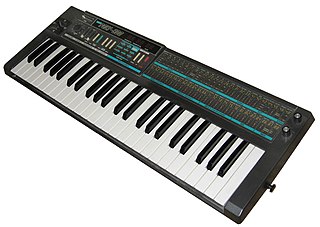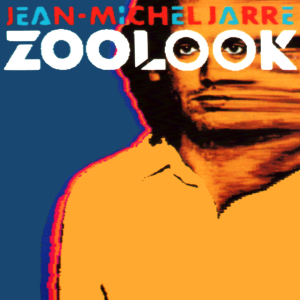Related Research Articles

An electronic musical instrument or electrophone is a musical instrument that produces sound using electronic circuitry. Such an instrument sounds by outputting an electrical, electronic or digital audio signal that ultimately is plugged into a power amplifier which drives a loudspeaker, creating the sound heard by the performer and listener.

MIDI is a technical standard that describes a communication protocol, digital interface, and electrical connectors that connect a wide variety of electronic musical instruments, computers, and related audio devices for playing, editing, and recording music.

The Roland TB-303 Bass Line is a bass synthesizer released by Roland Corporation in 1981. Designed to simulate bass guitars, it was a commercial failure and was discontinued in 1984. However, cheap second-hand units were adopted by electronic musicians, and its "squelching" or "chirping" sound became a foundation of electronic dance music genres such as acid house, Chicago house and techno. It has inspired numerous clones.

The Mellotron is an electro-mechanical musical instrument developed in Birmingham, England, in 1963. It is played by pressing its keys, each of which causes a length of magnetic tape to contact a capstan, which pulls it across a playback head. As the key is released, the tape is retracted by a spring to its initial position. Different portions of the tape can be played to access different sounds.
A music sequencer is a device or application software that can record, edit, or play back music, by handling note and performance information in several forms, typically CV/Gate, MIDI, or Open Sound Control, and possibly audio and automation data for digital audio workstations (DAWs) and plug-ins.

A groovebox is a self-contained electronic or digital musical instrument for the production of live, loop-based electronic music with a high degree of user control facilitating improvisation. The term "Groovebox" was originally used by Roland Corporation to refer to its MC-303, released in 1996. The term has since entered general use, and the concept dates back to the Movement Computer Systems Drum Computer in 1981.

Oberheim is an American synthesizer manufacturer founded in 1969 by Tom Oberheim.

The Roland TR-909 Rhythm Composer, commonly known as the 909, is a drum machine introduced by Roland Corporation in 1983, succeeding the TR-808. It was the first Roland drum machine to use samples for some sounds, and the first with MIDI functionality, allowing it to synchronize with other devices. Though a commercial failure, it influenced the development of electronic dance music genres such as techno, house and acid house.

The Korg M1 is a synthesizer and music workstation manufactured by Korg from 1988 to 1995. It is one of the bestselling synthesizers in history, selling an estimated 250,000 units. The M1 was widely used in popular music and stock music in the late 80s and early 90s. The piano and organ presets were used in 1990s house music, beginning with Madonna's 1990 single "Vogue".

The Yamaha CS-80 is an analog synthesizer introduced by Yamaha Corporation in 1977. It supports true 8-voice polyphony, with two independent synthesizer layers per voice each with its own set of front panel controls, in addition to a number of hardwired preset voice settings and four parameter settings stores based on banks of subminiature potentiometers.

The Korg Poly-800 is a synthesizer released by Korg in 1983. Its initial list price of $795 made it the first fully programmable synthesizer that sold for less than $1000. It featured a 49 key non-velocity-sensitive keyboard, two buttons for data entry, and a joystick controller, which could modulate the DCO pitch or the VCF. Though the Poly-800 had MIDI, it did not feature MIDI SysEx functionality, and patches had to be backed up to cassette tape. It had 8-voice polyphony (paraphony) with one DCO per voice. It could be switched into double mode which stacks two DCOs for a fuller sound, but reduces the polyphony to 4 voices. It featured one analog resonant low-pass VCF with 24 dB/oct which was shared for all voices. Like a monophonic synthesizer, the filter was switchable between single or multiple modes. In single mode, the first key pressed triggers the filter envelope, and unless all keys are released, the filter does not re-trigger. In multi mode, each key pressed in turn triggers the filter envelope, even if other keys are still pressed down. Further it had three digital envelope generators, a noise generator, an LFO, and a chorus effect. The Poly-800 could be run off batteries and had guitar strap pegs, allowing a performer to wear it like a guitar. It was also available with reversed-colored keys, which gave an appearance similar to a Vox Continental organ.

The Korg OASYS is a workstation synthesizer released in early 2005, 1 year after the successful Korg Triton Extreme. Unlike the Triton series, the OASYS uses a custom Linux operating system that was designed to be arbitrarily expandable via software updates, with its functionality limited only by the PC-like hardware.

Zoolook is the seventh studio album by French electronic musician and composer Jean-Michel Jarre, released in November 1984 by Disques Dreyfus. Much of the music is built up from samples of singing and speech in 25 different languages recorded and edited in the Fairlight CMI digital sampling synthesizer. The album spawned two singles: the title track and "Zoolookologie".

The RolandJuno-60 is an analog synthesizer manufactured by the Roland Corporation between 1982 and 1984. It followed the Juno-6, an almost identical synthesizer released months earlier. The Juno synthesizers introduced Roland's digitally controlled oscillators, allowing for greatly improved tuning stability over its competitors.

"Hymn" is a 1982 song from Ultravox's sixth studio album Quartet. Released as the album's second single, it reached #11 on the UK Singles Chart and the Top 10 in Germany and Switzerland.
The Entertainment Computer System (ECS) was an add-on peripheral for the Intellivision. It was Mattel Electronics' second attempt at creating a peripheral to upgrade the Intellivision into a home computer, and was rushed into production to appease the Federal Trade Commission after they began fining Mattel for false advertising following consumer complaints about the repeated delays in releasing the originally planned Intellivision Keyboard Component add-on. The ECS includes the Computer Module, Music Synthesizer, and additional hand controllers; each sold separately. Any Intellivision Master Component is compatible and a requirement to use the system. A second requirement is a cartridge plugged into the ECS, although any ECS or Intellivision cartridge will do; pressing anything on the Intellivision hand controllers will then bring up the three-option menu of BASIC, CARTRIDGE or MUSIC.

The Elka Synthex is a polyphonic analog synthesizer produced by Italian music instrument manufacturer Elka from 1981 to 1985.
Electronic Dream Plant (EDP) was a small British synthesizer manufacturer, active during the late 1970s and early 1980s. At the time their products were not particularly successful commercially. In later years products like the "WASP" became prized by collectors for their unique sound, and later synthesizer companies have successfully copied some of their design elements.

The Roland VP-330 is a paraphonic ten-band vocoder and string machine manufactured by Roland Corporation from 1979 to 1980. While there are several string machines and vocoders, a single device combining the two is rare, despite the advantage of paraphonic vocoding, and the VP-330's synthetic choir sounds are unique. Despite the VP-330's electronic string and choir sounds being less realistic than those of the tape-based Mellotron, touring musicians used it as a lighter and more robust alternative.

Teenage Engineering is a Swedish consumer electronics company and manufacturer founded in 2005 by Jesper Kouthoofd, David Eriksson, Jens Rudberg and David Möllerstedt and based in Stockholm. Its products include electronics and synthesizers, with its core product being the OP-1, as well as instant cameras.
References
- 1 2 "Doctor Click (EMM Nov 83)". Electronics & Music Maker (Nov 1983): 30–31. November 1983.
- ↑ "GARFIELD ELECTRONICS Doctor Click". www.jarrography.free.fr.
- ↑ "Garfield Electronics Doctor Click". www.matrixsynth.com.
- ↑ "Doctor Click (EMM Nov 83)". Electronics & Music Maker (Nov 1983): 30–31. November 1983. Retrieved 2018-06-26.